In Vietnamese culture, the altar is the most sacred and revered place, where the ancestors of the family reside, and is typically placed in the most prominent spot in the house.
The worship space is a sacred area, and thus, keeping the altar clean shows respect and devotion to the ancestors from the descendants.
Therefore, when cleaning the altar for the Lunar New Year, one must be extremely cautious to avoid any spiritual offenses. If not done properly, it could affect the family’s fortune and luck. Let’s find out what to use to clean the altar and the correct way to do it!
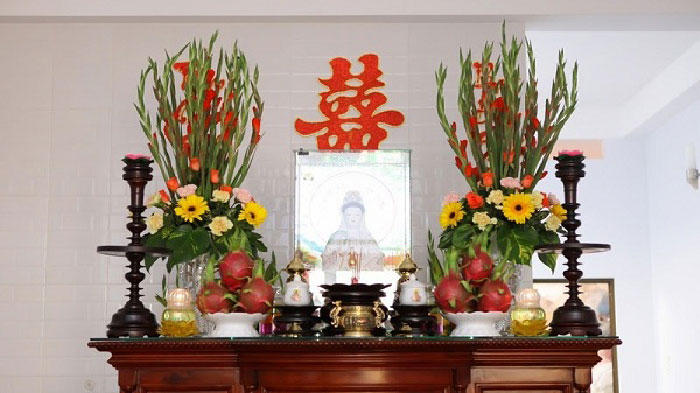
1 When to Clean the Ancestral Altar for the Lunar New Year?
On regular days, family members can clean the altar whenever they feel it is dirty or on special occasions, usually doing so a day in advance.
However, during the Lunar New Year, families tend to be more thorough with this task, often referring to it as “bao sái”. There are two ideal times for “bao sái”: the day of sending off the Kitchen God and the day of welcoming him back. And it must be done before the night of the New Year’s Eve.
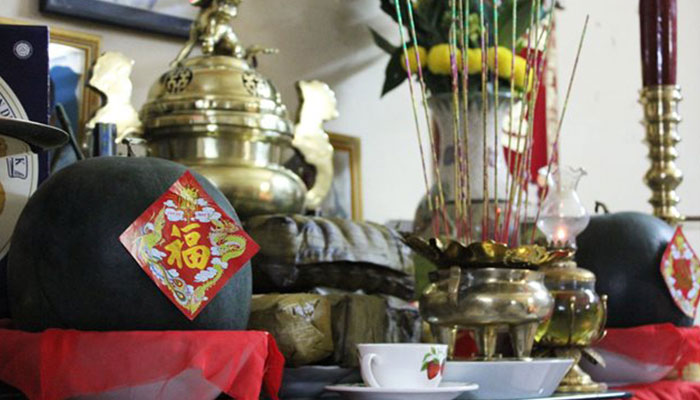
According to Vietnamese customs, people are very reluctant to sweep or clean on the first day of the New Year as they believe that doing so will sweep away all their fortune and luck. Therefore, cleaning the house and ancestral altar should be done before the New Year’s Eve.
Additionally, this timing is chosen because it is when the Kitchen God is away, and any adjustments to the altar will not be considered offensive. By the time he returns, the altar will be clean and ready to welcome him.
2 Who Should Clean the Ancestral Altar for the Lunar New Year?

The person responsible for cleaning the ancestral altar should ideally be a family member (usually the head of the family), someone who is not injured, or a woman who is not on her period. The cleaner should take a bath and dress neatly before starting the cleaning process.
Note: It is not recommended to ask for help from outsiders when cleaning the ancestral altar.
3 How to Clean the Ancestral Altar for the Lunar New Year
Take a Bath and Dress Neatly
Before cleaning the ancestral altar, the person in charge must bathe and dress neatly to show their sincerity and respect.
Additionally, before starting the “bao sái”, it is necessary to open all the doors and windows of the house.
Prepare the Necessary Tools and Materials
The person in charge should prepare clean tools and materials exclusively for cleaning the ancestral altar. Prepare diluted alcohol with ginger to clean the altar. If there are Buddhist statues or pictures, use only warm water to clean them, instead of alcohol.

Prepare a separate table covered with red cloth or paper to place the ancestral tablets. If the family has both ancestral tablets and spirit tablets, they must be placed separately. Wait for the incense to burn out before starting the cleaning process.
Inform the Ancestors by Burning Incense
Before cleaning the ancestral altar, it is essential to prepare flowers, light incense, and inform the ancestors, asking for their permission to proceed with the “bao sái”.
At the same time, the person in charge should prepare a table covered with red cloth or paper to place the ancestral tablets, incense burners, lamps, candles, and decorative items from the altar. Wait for the incense to burn out before starting the cleaning process.

Steps to Clean the Ancestral Altar
First, remove the items from the altar that need to be cleaned. Place all the ancestral tablets and worship items neatly on the table, avoiding clutter.
Note: Do not move or shift the direction of the incense burner. According to folklore, moving the incense burner to an inauspicious direction can bring bad luck to the family.
Use the clean cloth soaked in ginger alcohol to wipe all the worship items. Then, use a dry cloth to wipe them again. Clean each item one by one, keeping them neat and orderly, avoiding clutter.
Note: Do not clean the items directly on the altar.
After cleaning the ancestral tablets, move on to cleaning the incense burner. Wash your hands with ginger alcohol, and use one hand to hold the incense burner steady to avoid shifting its direction. Use a dry cloth or broom to wipe away the dust from the mouth and around the incense burner, letting the dust fall onto the altar.
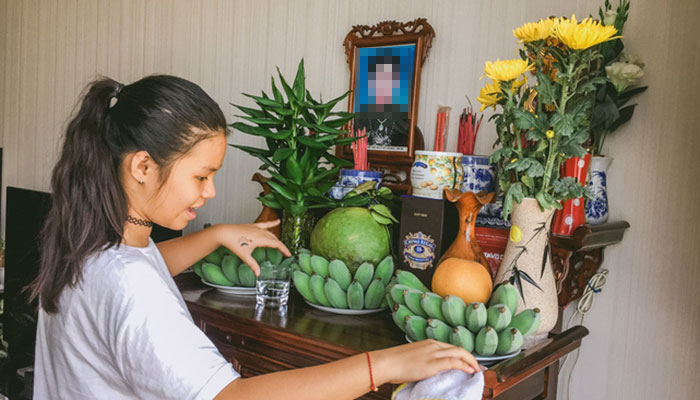
Nowadays, most people pull out the incense sticks and hold the incense burner to pour out the ash, which can easily cause “scattering of wealth”. The correct way to remove the ash is to use a small spoon to scoop out the ash gradually and then clean the incense burner. Afterward, fill the incense burner with new ash, symbolizing “money flowing in like water”.
After cleaning, use both hands to pull out the incense sticks one by one until there are an odd number of sticks left (1/3/5/7/9). Usually, five incense sticks are left in the incense burner for the spirit tablet (the gathering of the five elements) and three for other incense burners (generating wealth). Place the removed incense sticks on the table covered with cloth or red paper.

Finally, use a dry cloth to wipe away all the dust and ash from the altar. Then, use a clean cloth soaked in alcohol to wipe the altar again, followed by another wipe with a dry cloth.
Put the worship items back in their original positions, replace the flowers and candles (if necessary), and inform the ancestors that the task is completed.
During the cleaning process, it is essential to pay attention to certain taboos to avoid offending the spirits and to preserve the family’s fortune. Let’s explore these taboos in the following section!
For reference: Simple ways to clean the ancestral altar and taboos to avoid
4 Prayers for Cleaning the Ancestral Altar for the Lunar New Year
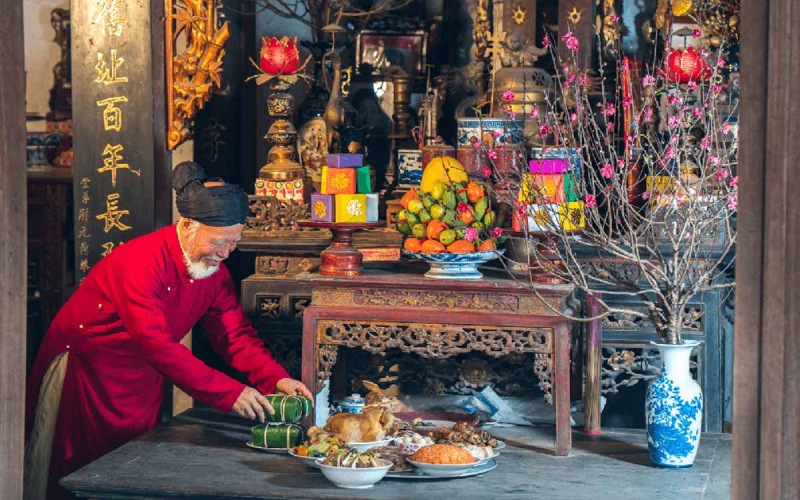 Prayers for Cleaning the Ancestral Altar for the Lunar New Year
Prayers for Cleaning the Ancestral Altar for the Lunar New Year
Nam mô a di Đà Phật!
Nam mô a di Đà Phật!
Nam mô a di Đà Phật!
We bow to the Nine Skies, the Ten Directions, and the Buddhas of the Ten Directions.
We bow to the Jade Emperor, the God of the Earth, the Five Directions and Five Elements, the Dragon Vein God, and the Kitchen God.
We, the descendants, whose name is: ……………..
Living at: ………………….
We bow to the spirits of our ancestors, the Nine Generations of the Seven Lines, the female ancestors, the Red Boy and Girl, and the ancestors of the ………… family at ………… (address of the house, hometown).
Today is the 23rd day of the twelfth month of the year ….., we ask for permission to clean the ancestral altar to welcome the New Year, hoping that the Buddhas, the ancestors, the female ancestors, the Red Boy and Girl, and the spirits of the …….. family will approve.
Nam mô a di Đà Phật!
Nam mô a di Đà Phật!
Nam mô a di Đà Phật!
5 Things to Note When Cleaning the Ancestral Altar
Tools and Materials for Cleaning the Ancestral Altar
Since it is a sacred and revered area, even the tools and materials used for cleaning the ancestral altar must be carefully selected. Items like cloths and brooms should be exclusive to the altar and not used for any other purpose. During the Lunar New Year, Vietnamese families often buy new sets of these tools and materials for cleaning the ancestral altar.
The water used for cleaning should be clean, and some people prefer to use warm water or white alcohol.
Do Not Pour Out All the Ash at Once When Cleaning the Incense Burner
When cleaning the incense burner, avoid pouring out all the ash at once. Instead, use a spoon to scoop out the ash gradually. Then, fill the incense burner with new ash, symbolizing “small outflow and large inflow”, which is good for the family’s finances.
The old ash and incense sticks should be burned and scattered in a clean river or lake, avoiding dirty and polluted places.
The incense burner is a familiar item on the ancestral altars of Vietnamese families. It is used to hold incense sticks and preserve spiritual values, wishes, and prayers of the descendants for their ancestors. Depending on the region, families may have one to three incense burners on their ancestral altars.
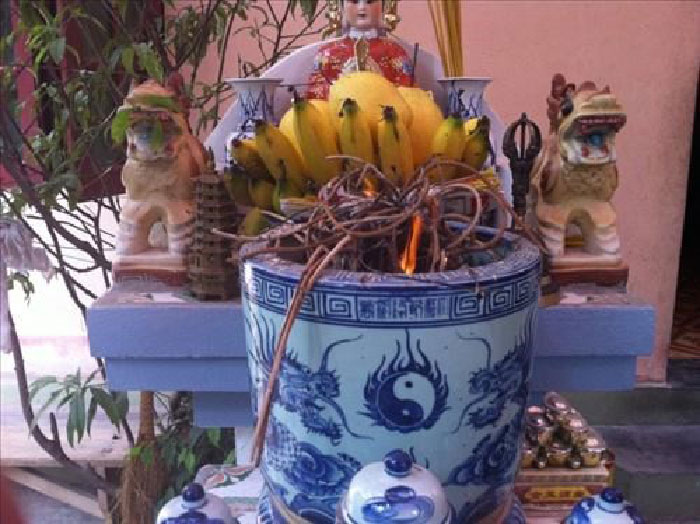
Avoid Breaking Worship Items
These items are sacred and hold significant spiritual value for Vietnamese people, so it is essential to be extremely careful with items like flower vases and objects made of porcelain or glass, keeping them in a safe place to avoid breakage.
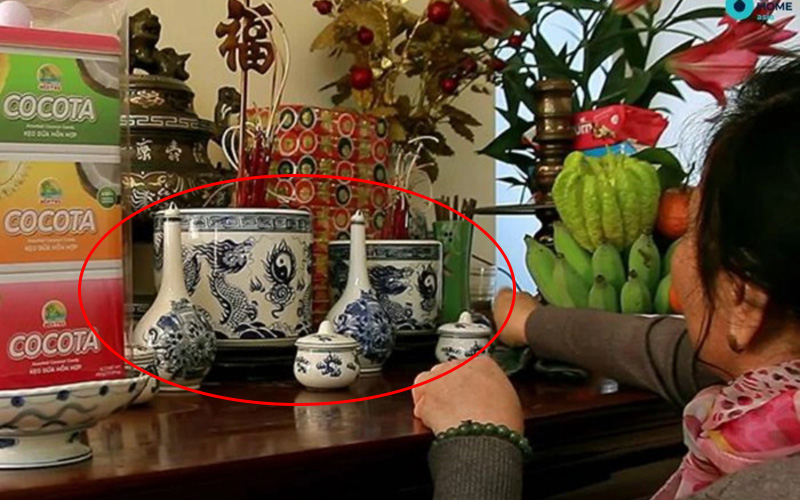
Particularly for the incense burner, it is believed to be a guide for the spirits, gods, and ancestors to witness and protect the family. Therefore, during the cleaning process, avoid shifting the direction of the incense burner too much.
After cleaning, it is also advisable to light incense and pray for good luck and fortune for the family.
6 When is the Best Time to Clean the Ancestral Altar for the Lunar New Year in 2024?
From the 23rd day of the twelfth month, after the Kitchen God Ceremony, families should start cleaning the ancestral altar for the Lunar New Year. The cleaning process should be completed before 12:00 midnight on New Year’s Eve. According to Eastern beliefs, this is the time when the “spirits are away”. Therefore, the family can rearrange and decorate the altar without offending the higher beings.
According to folk beliefs, the best time of the day to clean the ancestral altar is from 6:00 am to 11:55 am or from 1:00 pm to 5:55 pm. It is taboo to clean the ancestral altar during the Lunar New Year while on your period or when your body is not clean and well-groomed.







































